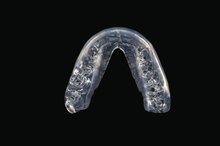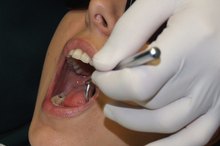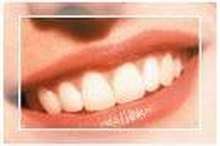What does fact checked mean?
At Healthfully, we strive to deliver objective content that is accurate and up-to-date. Our team periodically reviews articles in order to ensure content quality. The sources cited below consist of evidence from peer-reviewed journals, prominent medical organizations, academic associations, and government data.
- MedlinePlus: Aging Changes In The Face
- NIH Osteoporosis and Related Bone Diseases National Resource Center: Oral Health and Bone Disease
- MedlinePlus: Aging Changes in the Bones - Muscles - Joints
The information contained on this site is for informational purposes only, and should not be used as a substitute for the advice of a professional health care provider. Please check with the appropriate physician regarding health questions and concerns. Although we strive to deliver accurate and up-to-date information, no guarantee to that effect is made.
What Causes the Mouth to Look Sunken As We Age?
While it is natural to lose some muscle tone and acquire a few age-related wrinkles on your cheeks and around your lips, a sunken mouth and receding jaw line is not a normal part of the aging process. Lifestyle choices such as smoking and poor dental hygiene have a direct affect on the health of your gums, teeth and jaw. With proper nutrition, daily oral care and regular dental checkups, it is possible to keep a healthy mouthful of teeth and a jaw line that will continue to support your mouth and lower face well into old age.
Bone Loss
Women diagnosed with osteoporosis are more susceptible to tooth loss, according to the National Institute of Arthritis and Musculoskeletal and Skin Disease. And regardless of sex, a damaged or missing tooth can cause infection that, if ignored, can spread to the tooth root and contribute to bone loss. To maintain the integrity of your jaw line, missing teeth should be replaced with a removable or permanent appliance, a crown or dental implant.
Poor Denture Fit
How Do I Repair a Partial Plate Denture?
Learn More
A sunken upper lip, jaw line and wrinkles around your mouth and cheeks might mean it is time to replace your dentures. Properly fitting dentures provide support for your cheeks, lips and facial muscles and enhance your smile and appearance. A well-fitted set of dentures should last for approximately five years, according to the West Vancouver Denture Clinic in British Columbia 5.
Gum Disease
Excessive bacteria, inflammation and infection deteriorate the gums and surrounding tissue around the teeth. Receding gums gradually move away from the teeth and create pockets that hold infection and increase inflammation. Untreated, gum disease contributes to tooth loss and can affect the rate of bone loss in the jaw line that results in a sunken mouth and jaw line.
Considerations
DIY Bite Guard
Learn More
Although aging is inevitable, a nutritious diet, daily brushing and flossing, routine visits to your dentist and prompt treatment of dental problems will help to maintain a strong jaw line that supports your mouth and lower face structure. Consult with your dentist if you experience any problems with bleeding gums, loose teeth or have difficulty chewing food; indications that suggest a change in your oral health.
Related Articles
References
- MedlinePlus: Aging Changes In The Face
- NIH Osteoporosis and Related Bone Diseases National Resource Center: Oral Health and Bone Disease
- MedlinePlus: Aging Changes in the Bones - Muscles - Joints
- American Health & Beauty: Dental Facelift: Reverse The Signs of Aging With Crowns And Veneers
- West Vancouver Denture Clinic Inc: Reline or New Denture?
- Bollen CM, Beikler T. Halitosis: the multidisciplinary approach. Int J Oral Sci. 2012;4(2):55-63. doi:10.1038/ijos.2012.39
- Islam B, Khan SN, Khan AU. Dental caries: from infection to prevention. Med Sci Monit. 2007;13(11):RA196-203.
- Dhadse P, Gattani D, Mishra R. The link between periodontal disease and cardiovascular disease: How far we have come in last two decades ?. J Indian Soc Periodontol. 2010;14(3):148-54. doi:10.4103/0972-124X.75908
- Malhotra R, Kapoor A, Grover V, Kaushal S. Nicotine and periodontal tissues. J Indian Soc Periodontol. 2010;14(1):72-9. doi:10.4103/0972-124X.65442
- National Institute of Dental and Cranial Research. Oral Cancer.
- Ram H, Sarkar J, Kumar H, Konwar R, Bhatt ML, Mohammad S. Oral cancer: risk factors and molecular pathogenesis. J Maxillofac Oral Surg. 2011;10(2):132-7. doi:10.1007/s12663-011-0195-z
- InformedHealth.org [Internet]. Cologne, Germany: Institute for Quality and Efficiency in Health Care (IQWiG); 2006-. Canker sores (mouth ulcers): Overview. 2019 Aug 15. Available from: h
- InformedHealth.org [Internet]. Cologne, Germany: Institute for Quality and Efficiency in Health Care (IQWiG); 2006-. Cold sores: Overview. 2018 Jul 12.
- Kanzow P, Wegehaupt FJ, Attin T, Wiegand A. Etiology and pathogenesis of dental erosion. Quintessence Int. 2016;47(4):275-8. doi:10.3290/j.qi.a35625
- Bartlett DW, Ide M. Dealing with sensitive teeth. Prim Dent Care. 1999;6(1):25-7.
- American Dental Association. Concerns.
- CDC. Dental Caries (Tooth Decay)
- National Institute of Dental and Cranial Research. Periodontal (Gum) Disease: Causes, Symptoms, and Treatments.
- National Institute of Dental and Cranial Research. Oral Cancer.
Writer Bio
Susan Brassard writes about natural health-related topics, complementary and alternative medicine and issues relative to a holistic approach to the aging process. Following a career in business and finance, she obtained a Master of Arts in gerontology and several certifications in energy therapies. She is the author of a workbook and resource guide for older adults.









